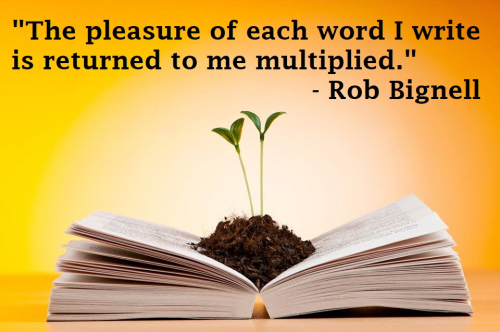Rob Bignell's Blog, page 208
July 21, 2018
Every success story begins with a dream. If you dream of...

Every success story begins with a dream. If you dream of being a professional, published author, that success story requires believing in yourself and in knowing that your efforts will lead to triumph. Read the motivational blog entry this quotation came from by clicking on the quote card.
Professional Book Editor: Having your novel, short story or nonfiction manuscript proofread or edited before submitting it can prove invaluable. In an economic climate where you face heavy competition, your writing needs a second eye to give you the edge. I can provide that second eye.
<A HREF=���http://ws-na.amazon-adsystem.com/widg... Widgets</A>
Related articles
 Five Great Quotations about the Writing Process
Five Great Quotations about the Writing Process 5 Writing Prompts for Science Fiction Writers - Inventing Reality Editing Service
5 Writing Prompts for Science Fiction Writers - Inventing Reality Editing Service Editing clients publish book for college students - Inventing Reality Editing Service
Editing clients publish book for college students - Inventing Reality Editing Service 5 Novums for Science Fiction Writing Prompts
5 Novums for Science Fiction Writing Prompts 5 Writing Prompts for Science Fiction Writers
5 Writing Prompts for Science Fiction Writers
July 20, 2018
How to Market Your Book: 7 Minutes a Day to Promoting Yo...

How to Market Your Book: 7 Minutes a Day to Promoting Your Book shows how to develop a strategy that will get articles about your self-published book in newspapers, magazines, on radio and television programs, posted on blogs, and linked to on websites, while landing you book signings and readings, all at virtually no cost.
<A HREF=���http://ws-na.amazon-adsystem.com/widg... Widgets</A>
Related articles
 Writing Inspiration: Who are you?
Writing Inspiration: Who are you? Writing Inspiration: Seek another's advice
Writing Inspiration: Seek another's advice Five Great Quotations about the Writing Process
Five Great Quotations about the Writing Process Make tables readable in your self-published book
Make tables readable in your self-published book Four ways to write a great tweet that sells books
Four ways to write a great tweet that sells books
July 19, 2018
Repurpose your writing to maximize revenue
Just because  a blog entry has been published doesn���t mean that it never can be used again. Instead, you want to repurpose your writing, meaning reformat and reuse it across multiple books as well as marketing and social media channels.
a blog entry has been published doesn���t mean that it never can be used again. Instead, you want to repurpose your writing, meaning reformat and reuse it across multiple books as well as marketing and social media channels.
Doing so helps you reach a wider audience. That���s because some people prefer receiving information in very specific ways ��� some like videos, others prefer infographics, a few want books ��� and these potential buyers of your books or service may never read your blog. If played right, repurposing also maximizes your income by allowing you to produce more products or ad revenue streams. Lastly, repurposing helps alleviate the stress of constantly coming up with new content.
To repurpose your writing, begin by identifying your evergreen content. This writing is relevant to your readers for a long time; for example, if you write about skiing, ���10 Tips for Beginning Skiers��� will be good for years to come. Non-evergreen writing usually centers on trends or news events, such as an analysis of the ski competition at the last Olympics.
Repurposing involves reworking the writing so that it can be seen in a new medium. Information always is presented slightly differently in each medium. For example, in radio you can���t refer to or show pictures and so with words or sound effects must describe a scene; in television, you can brings up pictures for viewers to see, so spoken descriptions can be pared down and often deleted.
There are several ways to repurpose your blog entries:
��� Roundups ��� For a new blog entry, offer a collection of links to all of the articles you���ve written about a theme/topic. This then can become an outline for a new book that you���ve already partially written!
��� Ebooks ��� After identifying blogs with similar themes/content, outline and begin writing a new ebook. You likely will have to write new content to introduce the book and to fill in the gaps, but those in turn can be new blog entries.
��� Videos ��� A blog entry can be the basis for a great script. The video can be posted on your website or at YouTube.
��� Infographics ��� Distill your blog down to a few key takeaways and add some illustrations to it for a visually pleasing, quick read. Free infographic templates are available online.
��� Slide shows ��� Using programs like PowerPoint, you can convert blogs entries to slide shows by breaking paragraphs into bullet points presented across several slides. These can be become new blog entries, used at presentations, or posted on SlideShare at LinkedIn.
��� Newsletter articles ��� If you put out a newsletter to promote your service or books, find an old blog entry that might be of interest to your readers today.
Of course, repurposing isn���t limited to blog entries. Content you���ve written for the above mediums easily could be repurposed into a blog or any of the other ways given. A blog can be broken down into blog entries. Scripts for videos could become an ebook. Slide shows can become videos. Be creative!
When you repurpose your content, remember to always do the following:
��� Update the facts ��� Stats and even facts quickly become outdated, and you want to be as current as possible. In our information age, you can bet that new studies and reports have come out if more than a year has passed since you wrote the blog. The more recent numbers and facts actually are likely to bolster your arguments. An outdated number or fact undercuts your piece, however.
��� Check the links ��� You���ll also want to check any links you may have in the blog entry. Over time, website pages disappear, and you don���t want to send out material with links that were good three years ago but are now broken. If they don���t work, you���ll need to either find new, relevant links or eliminate any reference to the link.
Professional Book Editor: Having your novel, short story or nonfiction manuscript proofread or edited before submitting it can prove invaluable. In an economic climate where you face heavy competition, your writing needs a second eye to give you the edge. I can provide that second eye.
<A HREF=���http://ws-na.amazon-adsystem.com/widg... Widgets</A>
Related articles
 Writing Inspiration: Seek another's advice
Writing Inspiration: Seek another's advice Five Great Quotations about the Writing Process
Five Great Quotations about the Writing Process Make tables readable in your self-published book
Make tables readable in your self-published book
July 18, 2018
Overlapping meaning: Repression vs. Suppression
When choosing  which of these two words to use, you may have to hold back a bit or even stop what you���re doing. Read on!
which of these two words to use, you may have to hold back a bit or even stop what you���re doing. Read on!
Repression is a noun meaning to inhibit or to prevent an action, usually by force. People, objects and ideas both can be repressed. To wit, The gunman for years engaged in repression of his anger and The dictator actively engaged in repression of the ethnic group���s political rights.
Suppression is a noun with a similar but subtly different meaning of putting an end to an action, of blockage and stoppage. For example, The dictator achieved supreme power through suppression of the press.
Hence, a dictator may be involved in repression of the press by arresting reporters who write critical stories about him, he doesn���t shut down the news media. A dictator engaged in suppression of the press would simply shut down all news media then arrest editors and reporters alike, regardless of what they wrote.
There is some overlap in the meanings of repression and suppression, leading to confusion among writers. Suppression obviously may involve some of the activities that would occur during repression.
Professional Book Editor: Having your novel, short story or nonfiction manuscript proofread or edited before submitting it can prove invaluable. In an economic climate where you face heavy competition, your writing needs a second eye to give you the edge. I can provide that second eye.
<A HREF=���http://ws-na.amazon-adsystem.com/widg... Widgets</A>
Related articles
 Five Great Quotations about the Writing Process
Five Great Quotations about the Writing Process Writing Inspiration: Seek another's advice
Writing Inspiration: Seek another's advice Make tables readable in your self-published book
Make tables readable in your self-published book
July 17, 2018
7 steps in outlining your short story/novel
Writers always  should outline their story before penning it ��� but just how should they go about the process of outlining? What would an outline look like?
should outline their story before penning it ��� but just how should they go about the process of outlining? What would an outline look like?
There are as many different approaches to outlining as there are writers. Some prefer paragraph summaries. Others like the elementary school 1, 1A, 1B, 2, 2A, 2B approach. A few like to pen scenes on notecards. Others create elaborate box charts. Use what works best for you, and if you���re uncertain what does, then experiment.
Whichever approach you use, you���ll want to follow these basic seven steps: premise; backstory; inciting incident; rising action; climax; revise��� and write first draft.
Premise
Begin your outline by establishing your premise. In fiction, it���s the basic idea of a story and usually answers four questions:
��� Who is the protagonist?
��� What is the central problem the protagonist must solve?
��� What is an internal conflict that the protagonist has that might prevent him from solving the problem?
��� Who is the antagonist?
A premise might be: A British spy (protagonist) sent to create a resistance cell in a Nazi-occupied village (central problem) falls in love with a local woman who fears a cruel SS chief (antagonist) will retaliate against her family and community should they present any problems for the occupiers, leading our hero to question his orders (internal conflict).
Usually a premise can be stated in a single sentence. And often when the writing of a story falters, it���s because one of these four elements is missing or unclear.
Backstory
Next, create a backstory for your protagonist. Always ask what events occurred in your protagonist���s life that led him to this point. How have those events shaped him into the kind of a person he is as the story begins? For example:
Our spy, Graham Clark, has felt deeply about the women he loved but because of his sense of duty, had to forgo developing any relationships, losing each of his lovers. Because of this, he���s never been loved. Maybe the family of the last woman he loved died in a Nazi air raid, and he knows if they had married years back, he had the means to get them out of London to the north before the attacks began.
You may never use the backstory, but going through the exercise helps you formulate the character you���ll be working with through the tale. As in sports where coaches are more likely to win when they know the kind of player they are working with, so in writing authors are more likely to write a winning story when they know something about the protagonist they are working with. At best, you might be able to weave the backstory into your story as a key plot point.
Inciting incident
Next, sketch out the inciting incident, which is your story opening. During the opener, you must establish for readers the central problem to be solved, the protagonist, and the setting. Don���t select a setting because it���s cool or because you are familiar with it; instead, brainstorm about a location and time frame that allows your plot to best unfold. In addition, this is the moment in the outline when you decide your point of view. A very basic sketch of the inciting incident, using the paragraph summary approach, might be:
British spy Graham Clark pulls his rubber raft beneath a bush on a beach as Nazi searchlights scan the French sky overhead. Crouching, he pauses to take compass reading, estimates he is only three kilometers from Serein, where his contact awaits. He sees squadron of Nazi planes flying overhead on its way to England. What is tonight���s target ��� London? Portsmouth? Birmingham? Forming a resistance group in an occupied village sounds like fool���s errand when England itself is under attack. He hears a German voice and freezes. There���s a patrol on road above the beach.
Notice how these are incomplete sentences. The key in outlining scenes is merely to get the gist of what will happen.
Rising action
Next, determine your plot points. For a short story, you need a minimum of three scenes for the rising action plus a scene for the climax. In each scene, ask:
��� How does the protagonist attempt to resolve the central problem? This is his goal.
��� What obstacles hinder the protagonist from resolving the central problem and so create conflict?
��� How does he fail to resolve the goal?
��� What occurs in this scene that allows him to try again in the next scene?
Once you know the answers, sketch these scenes. For a scene in our spy story, you might write:
Graham, posing as a Frenchman, is with his contact, Mar��chal, who is to introduce him to a possible Resistance recruit, Philippe. From what Graham has observed, Philippe, the village baker���s assistant, lacks the common sense to be good at the secretive work they must do; Mar��chal attempts to assure him that Philippe���s heart is in the right place. Graham worries that simply talking to Philippe, especially if they must reject him, may doom his mission. There is a knock at the door; Mar��chal checks through a barely open blind and sees it is Philippe and lets him in. They greet each other warmly. Mar��chal introduces Graham to Philippe; the three make small talk about their workday. At last, much to Graham���s relief, Mar��chal invites Philippe into his den to see the wooden models of great French naval vessels. Mar��chal shows off several models (including one that defeated a British ship, just to rib Graham) and extols the greatness of French military prowess and history, which Philippe gets starry-eyed at. Graham asks if he served with the army during the German invasion. Philippe says he was too young, but his brother served. Mar��chal pats Philippe���s shoulder, says his brother served bravely. Philippe���s hands form into fists, and he nods. Mar��chal says there is a way he still might serve. Philippe looks at him confusedly. ���How? Is there a way to get to England and join the Free French?��� Mar��chal and Graham look at one another; Graham steps forward, ���No...but there is a way to help the Free French return.���
Our protagonist has not achieved his goal of creating an effective resistance, but he is closer to doing so, albeit by enlisting a potentially questionable recruit ��� which could lead to a setback in a future scene.
Climax
Once you���ve completed the scenes you need for the rising action, move on to sketch the climax. Ask yourself:
��� How does the protagonist attempt to resolve the central problem in this scene?
��� What obstacles hinder the protagonist from resolving the central problem and so create conflict? ��� How does he succeed in resolving the goal?
��� What occurs in the climax that allows him to finally succeed and defeat the antagonist?
Write out this scene just as would each scene of the rising action.
You also must sketch the falling action/denouement. This is where lose ends are tie up in the story.
Revise
Next, review and revise your outline. Ensure the scenes link together and that they follow your premise (or perhaps a new premise developed, in which case you need to change what you wrote as and that point in the outline and ensure the rest of what you���ve written matches this new storyline). Watch for gaps in the story and fix those plot holes. Also delete the rambling parts that don���t take your characters toward achieving their goal.
For example, in the above outlined scene for the rising action, we might add what the naval ships and battles that Mar��chal tells Philippe about. Outlining is a time to do research.
By the way, when outlining if you added snatches of dialogue, character descriptions or blow-by-blow details of the plot that came to you (and they probably will), good! That���s what an outline is all about ��� spurring your creativity and immediately organizing those thoughts. Just remember that because of this your outline may have a thoroughly developed scene and another scene that is still vague; as revising the outline, you���ll need to ensure that the weak scenes are equally as complete.
Writing first draft
Once you���ve written the outline, you���re now ready to write the first draft. Begin by reviewing your outline for the scene then start filling in the gaps. Remember that your outline is a living document. Course corrections are often needed and are perfectly acceptable during the first draft.
If you find yourself stuck as drafting a scene and notice that there���s not much in the outline to guide you, then that���s a sign at least that portion of the outline wasn���t complete. Go back and finish it up ��� then get back to penning that first draft!
Professional Book Editor: Having your novel, short story or nonfiction manuscript proofread or edited before submitting it can prove invaluable. In an economic climate where you face heavy competition, your writing needs a second eye to give you the edge. I can provide that second eye.
<A HREF=���http://ws-na.amazon-adsystem.com/widg... Widgets</A>
Related articles
 Five Great Quotations about the Writing Process
Five Great Quotations about the Writing Process Writing Inspiration: Seek another's advice
Writing Inspiration: Seek another's advice Make tables readable in your self-published book
Make tables readable in your self-published book
July 16, 2018
Why you should outline your short story/novel
Once you���ve  come up with a great story idea, always take a good amount of time thinking about how it will unfold. You can do so by outlining the story.
come up with a great story idea, always take a good amount of time thinking about how it will unfold. You can do so by outlining the story.
If you���re among those who eschew outlining, don���t kid yourself. You probably already are outlining the story in your head but are just hoping you remember it all, as you skip ahead to writing the first draft. Should you be among the rare few who have no trouble penning a draft, that���s great ��� you can skip the rest of this article. But if you find your writing stalls out midway during the story or what you get at the end of the first draft is a mess about irresolvable as Middle Eastern conflicts, then read on.
There are several good reasons to outline your story. First, outlining actually is an act of creativity meant to spur you to being even more creative. You force yourself to think deeply about the story ��� who the characters are, the conflicts they have with one another, how those conflicts play out, and much, much more. In addition, outlines ensure your plot structure is solid, that your character arc works, that you cut the superfluous scenes before penning them. All too often non-outlined stories fall apart during the first draft because the writer failed to put enough thought into these basic underpinnings of their story. Indeed, outlines actually save you time and prevent frustration because you���re not relying on trial and error to get a scene or plot or character right. And once you start the first draft, you won���t wonder what to write or run out of ideas. Should your outline prove inadequate once you do start writing, you always can change it. An outline, after all, is a living document.
Simply put, contrary to some writers��� claims, outlining does not bottle up your creativity. Neither does an outline confine you by forcing you to follow preset plans.
Instead, think of an outline as if it were a first draft ��� except rather than writing out detailed scenes in sentences and paragraphs, you���re writing them in shorthand. Your next draft involves filling in the details, as if writing in longhand.
In addition, always remember that there is no right or wrong way to outline a story. Different methods work for different people. Some outline by writing paragraph summaries. Others make box charts. Perhaps the reason a number of writers dislike outlining is that they believe it means doing so in a specific way, such as Roman numerals like we were taught in elementary school or using notecards like our high school English teacher told us, though for many writers both of those methods work as well.
In tomorrow���s entry, we���ll look at steps you might take in outlining a story or novel.
Professional Book Editor: Having your novel, short story or nonfiction manuscript proofread or edited before submitting it can prove invaluable. In an economic climate where you face heavy competition, your writing needs a second eye to give you the edge. I can provide that second eye.
<A HREF=���http://ws-na.amazon-adsystem.com/widg... Widgets</A>
Related articles
 Five Great Quotations about the Writing Process
Five Great Quotations about the Writing Process Writing Inspiration: Seek another's advice
Writing Inspiration: Seek another's advice Make tables readable in your self-published book
Make tables readable in your self-published book
July 15, 2018
5 Great Quotations about Story Ideas
���Every idea  is my last. I feel sure of it. So, I try to do the best with each as it comes and that���s where my responsibility ends. But I just don���t wait for ideas. I look for them. Constantly. And if I don't use the ideas that I find, they���re going to quit showing up.��� - Peg Bracken
is my last. I feel sure of it. So, I try to do the best with each as it comes and that���s where my responsibility ends. But I just don���t wait for ideas. I look for them. Constantly. And if I don't use the ideas that I find, they���re going to quit showing up.��� - Peg Bracken
���Sit and quiet yourself. Luxuriate in a certain memory and the details will come. Let the images flow. You'll be amazed at what will come out on paper. I���m still learning what it is about the past that I want to write. I don���t worry about it. It will emerge. It will insist on being told.��� - Frank McCourt
���My advice is not to wait to be struck by an idea. If you���re a writer, you sit down and damn well decide to have an idea.��� - Andy Rooney
���I have never felt like I was creating anything. For me, writing is like walking through a desert and all at once, poking up through the hardpan, I see the top of a chimney. I know there���s a house under there, and I���m pretty sure that I can dig it up if I want. That���s how I feel. It's like the stories are already there. What they pay me for is the leap of faith that says: ���If I sit down and do this, everything will come out OK.������ - Stephen King
���Ideas are like rabbits. You get a couple and learn how to handle them, and pretty soon you have a dozen.��� - John Steinbeck
Professional Book Editor: Having your novel, short story or nonfiction manuscript proofread or edited before submitting it can prove invaluable. In an economic climate where you face heavy competition, your writing needs a second eye to give you the edge. I can provide that second eye.
<A HREF=���http://ws-na.amazon-adsystem.com/widg... Widgets</A>
Related articles
 Five Great Quotations about the Writing Process
Five Great Quotations about the Writing Process Writing Inspiration: Seek another's advice
Writing Inspiration: Seek another's advice Make tables readable in your self-published book
Make tables readable in your self-published book
July 14, 2018
Professional Book Editor: Having your novel, short story...

Professional Book Editor: Having your novel, short story or nonfiction manuscript proofread or edited before submitting it can prove invaluable. In an economic climate where you face heavy competition, your writing needs a second eye to give you the edge. I can provide that second eye.
&amp;amp;amp;amp;amp;amp;amp;lt;A HREF=���http://ws-na.amazon-adsystem.com/widg... Widgets&amp;amp;amp;amp;amp;amp;amp;lt;/A&amp;amp;amp;amp;amp;amp;amp;gt;
Related articles
 Writing Inspiration: Seek another's advice
Writing Inspiration: Seek another's advice Editing client releases Battle of Britain novel - Inventing Reality Editing Service
Editing client releases Battle of Britain novel - Inventing Reality Editing Service Create visuals for your workshop presentation
Create visuals for your workshop presentation Writers must be comfortable with failure
Writers must be comfortable with failure 5 Novums for Science Fiction Writing Prompts
5 Novums for Science Fiction Writing Prompts
July 13, 2018
4 Tips to a Successful Email Marketing Campaign

��� Sell more books via email marketing campaign
��� Try these topics for email marketing campaigns
��� How to construct your email marketing message
��� How to know if your email marketing is working
��� BONUS: ���Words create sentences; sentences create paragraphs; sometimes paragraphs quicken and begin to breathe.���
Professional Book Editor: Having your novel, short story or nonfiction manuscript proofread or edited before submitting it can prove invaluable. In an economic climate where you face heavy competition, your writing needs a second eye to give you the edge. I can provide that second eye.
<A HREF=���http://ws-na.amazon-adsystem.com/widg... Widgets</A>
Related articles
 Five Great Quotations about the Writing Process
Five Great Quotations about the Writing Process Writing Inspiration: Seek another's advice
Writing Inspiration: Seek another's advice Make tables readable in your self-published book
Make tables readable in your self-published book
July 12, 2018
Learn More About Self-Publishing: Whether writing a nove...

Learn More About Self-Publishing: Whether writing a novel or nonfiction, whether planning to print a paperback or an ebook, 7 Minutes a Day to a Self-Published Book guides you through the self-publishing process, from the title page to the index, from designing a cover to formatting your text.
&amp;amp;amp;lt;A HREF=���http://ws-na.amazon-adsystem.com/widg... Widgets&amp;amp;amp;lt;/A&amp;amp;amp;gt;Related articles
 Writing Inspiration: Seek another's advice
Writing Inspiration: Seek another's advice Five Great Quotations about the Writing Process
Five Great Quotations about the Writing Process Make tables readable in your self-published book
Make tables readable in your self-published book 5 Writing Prompts For Science Fiction
5 Writing Prompts For Science Fiction Create video diary of writing process
Create video diary of writing process



